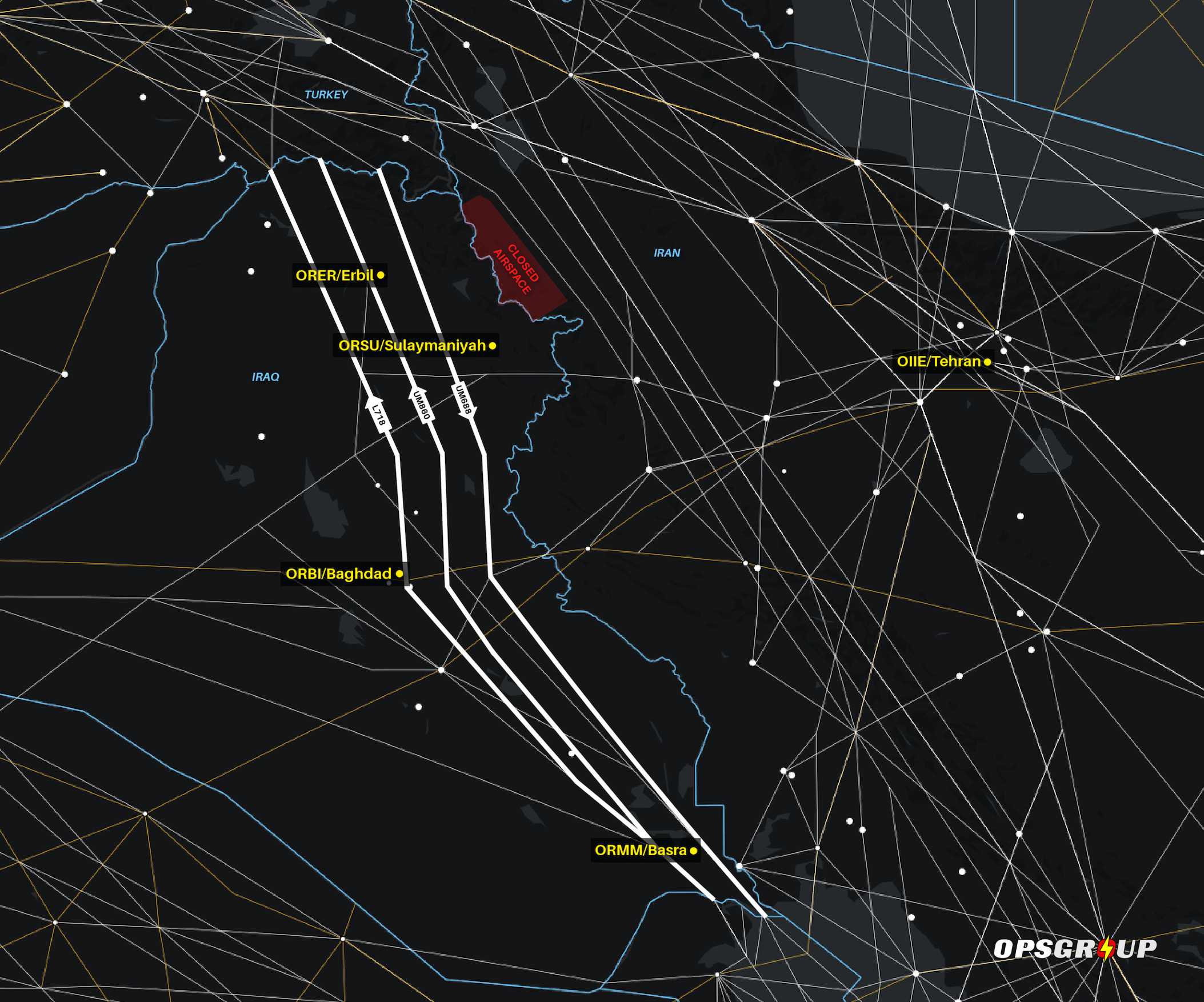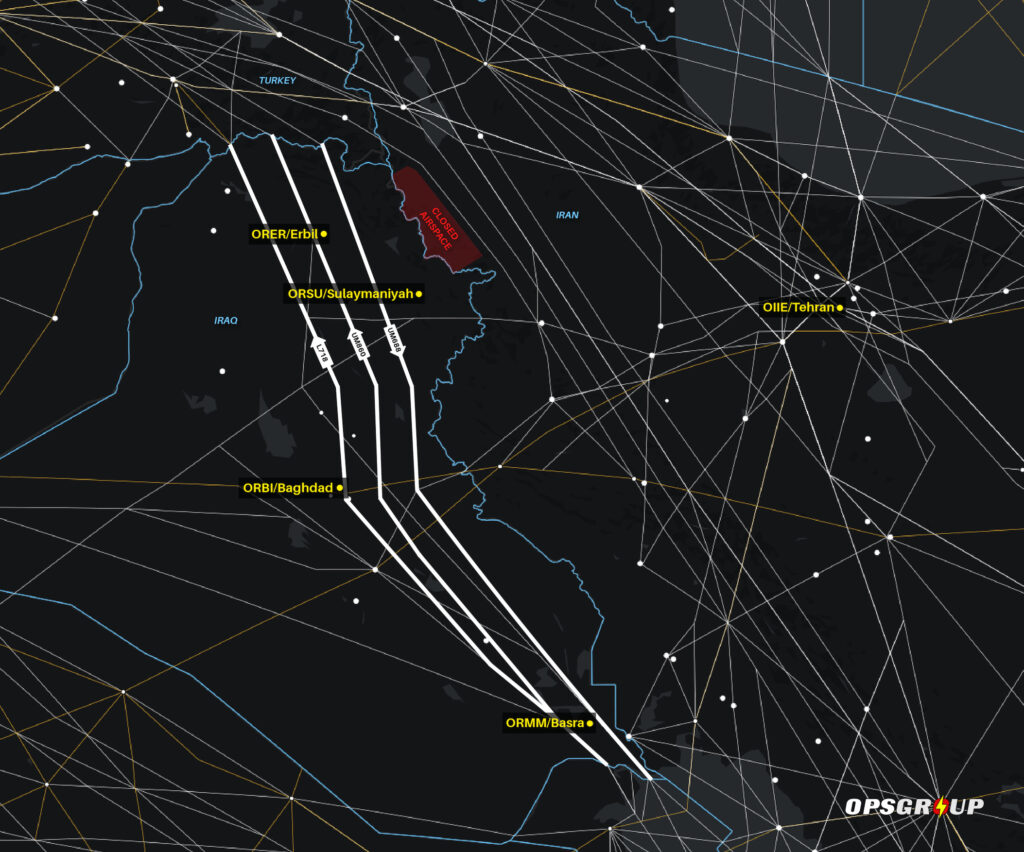International operators overflying Iraq should take note of recent events impacting airspace risk in the region.
Iran have closed a section of airspace in the north of the country along the border with Iraq, and are potentially using the area to launch missile and drone attacks at targets near ORER/Erbil airport, in close proximity to heavily flown international air routes.
Iranian attacks
Iran are warning their own operators against flying in Iraqi airspace, and especially at Erbil airport, which came under direct fire from Iranian surface-to-surface ballistic missiles in Feb 2021 and again in March 2022. Iran launched further attacks this week on an area 35 miles east of Erbil, reportedly targeting a Kurdish opposition group in the region – an armed opposition force that is banned in Iran.
Here is the warning issued by Iran:
OIIX A2959/22 - AIRSPACE SAFETY AND SECURITY WARNING ISSUED BY IRAN CAA IN RESPONSE TO THE HAZARDOUS SITUATION WITHIN THE TERRITORY AND AIRSPACE OF BAGHDAD FIR (ORBB), IRANIAN REGISTERED AIR OPERATORS ARE ADVISED TO TAKE ALL POTENTIAL RISKS INTO ACCOUNT IN RISK ASSESSMENT AND FLT PLANNING DECISIONS WHEN OPERATING AT AIRPORTS WHICH ARE LOCATED WITHIN BAGHDAD FIR (ORBB) ESPECIALLY ERBIL INTERNATIONAL AIRPORT (ORER), DUE TO THE RISK POSED BY MILITANT ACTIVITY AND LIMITED RISK MITIGATION CAPABILITIES IN IRAQ. 28 SEP 17:35 2022 UNTIL 05 OCT 18:30 2022 ESTIMATED. CREATED: 28 SEP 17:43 2022
Iraq airspace risk
Several countries warn against overflights of both Iran and Iraq. The US FAA bans N-reg aircraft from the OIIX/Tehran FIR, and says that overflights of the ORBB/Baghdad FIR must be at FL320 or above – and just last week they extended these rules to 2024.
But the Iranian attacks in northern Iraq raise questions and concerns about overflights of Iraq. Airways UM688 (southbound) and UM860 (northbound) through Iraq are popular routes for international flights between Europe and the Middle East. Is it really safe to fly these routes now, even above FL320?
It’s worth digging into the US FAA guidance on Iraq a bit deeper to get a clearer picture of exactly what the risk is here. SFAR 77 has the info, and this is (some of) what it says:
- Iranian-aligned militia groups (IAMGs) have access to UAS and anti-aircraft capable weapons systems which present inadvertent risks to the safety of U.S. civil aviation operations in the ORBB/Baghdad FIR at altitudes below FL320 and at potentially targeted airports.
- IAMGs likely lack the ability to conduct effective target identification and airspace de-confliction, increasing the risk of an accidental shoot down of a civil aircraft due to misidentification or misperception.
- In addition, the FAA remains concerned about cross-border military activity. Both Iran and Turkey have previously conducted various no-notice, cross-border operations striking targets in northern Iraq using a variety of weapons, including short-range ballistic missiles, rockets, and weaponized UAS. In a recent example, on March 12, 2022, up to twelve Fateh-110 surface-to-surface ballistic missiles launched from western Iran and impacted near the construction site of the new U.S. consulate in Erbil, Iraq, and Erbil International airport (ORER). While this attack did not pose a direct threat to the airport, the missile trajectories possibly presented an inadvertent risk to aircraft in flight that might have been operating at low altitude in the vicinity of Erbil International airport (ORER) during the time of the attack.
- In general, unannounced third-party cross-border operations in the Baghdad FIR (ORBB) present a low altitude safety-of-flight risk for aircraft flying in the vicinity of the targeted location(s) and for aircraft on the ground at airports co-located with, or in close proximity to, the intended targets. These activities also pose an airspace de-confliction challenge.
Should I avoid overflying Iraq?
For most Europe-Middle East flights, the route through Saudi-Egypt is a safer option than Iraq.
Even routing through Iran is probably a safer bet at the moment (although we don’t advise that either!). We received a report from an OPSGROUP member this week who routed through Iran:
“I would estimate our flights through Iran vs Iraq are taking (approximately) 10-15 mins longer, but at significantly less risk. We only consider airports that are served by either Emirates or FlyDubai as suitable for diversion, but only as a last resort, such as OIIE, OISS and OIFM. The company we use for support and handling if such diversions are required is Hadid. They are excellent for sorting any problems/permits in the Middle East.”
Here’s the Iraq risk, as we see it:
- Potential of intentional targeting by terrorist organisations who possess portable anti-aircraft weaponry.
- Civil aircraft may be misidentified by the air defence systems of both local and foreign military who are active in the country.
- Iraq is politically unstable, and security and safety on the ground is unpredictable and likely to be high risk.
- The US have pulled their troops out and so there is little protection at the major airports.
- ORBI/Baghdad and ORER/Erbil airports are common target for rocket attacks. Militia and terrorist groups are active in these areas.
Want a full briefing?
Just click here. Safeairspace.net is our conflict zone and risk database run by OPSGROUP. We continually assess the risk to operators the world over. It presents that information in a way that will always be simple, clear, and free. You can also add your email to our new fortnightly airspace risk briefing that contains only what you need to know, delivered every second Monday.
More on the topic:
- More: FAA warning issued, further serious navigation failures reported
- More: Flights misled over position, navigation failure follows
- More: Turkey, Syria and Iraq: Airspace Risk
- More: Iraq Overflights: A Recent Report
- More: US FAA allows Iraqi overflights
More reading:
- Latest: Venezuela & Caribbean Airspace Update
- Latest: ReFuelEU: Europe’s new anti-tankering rules explained
- Latest: US CBP biometrics: BizAv rollout still unclear
- Safe Airspace: Risk Database
- Weekly Ops Bulletin: Subscribe
- Membership plans: Why join OPSGROUP?












 Get the famous weekly
Get the famous weekly 





